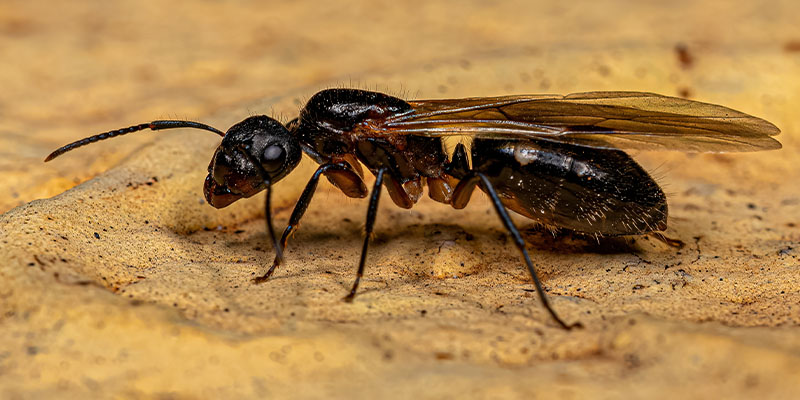Flying ants, eh? Sure, they look a little scary. And, because they can take to the air, these insects can get around with astonishing ease – including throughout your house! But, you shouldn’t panic. However, that doesn’t mean you should just ignore what you see, either. So, let’s put things in perspective.
First of all, flying ants are not your average, run-of-the-mill ants. These winged wonders are the reproductive members of the ant colony, which means they’re on a mission to find a mate and start a new colony. In turn, this means that if you see a swarm of flying ants in your house, it’s like an ant singles’ mixer happening right under your roof.
Now, should you be worried? Well, it depends on your definition of “worried.” If you’re afraid of being overrun by a swarm of love-struck ants, then yes, you might want to take some action. But if you’re just concerned about the potential damage they could cause, the answer is a bit more nuanced.
Flying ants themselves don’t cause direct harm to your home, but their presence could be a sign of a larger ant problem. If you’ve got a colony of ants living in your walls or foundation, that’s when you need to call in the pest control cavalry. But in the meantime, what can you do to get rid of these winged invaders? Fortunately, there are a few options available:
- Vacuum them up. This is like the ant equivalent of a black hole. Just suck ’em up and say goodbye to your unwanted guests.
- Use an insecticide spray or natural ant-killing spray. Just be careful not to use anything that could harm you, your pets, or the environment.
- Call in the professionals. If you’re not comfortable dealing with the situation yourself, you can always hire a pest control expert to handle it for you.
In the meantime, try to keep your home as clean and free of food debris as possible. Ants are like tiny detectives, and they’ll follow the trail of crumbs right to your pantry.
To sum it up: flying ants in your house are a bit of a nuisance, but they’re not necessarily a cause for alarm. Just take some steps to get rid of them and keep your home clean, and you should be able to keep the ant invasion at bay.
Why Are There Flying Ants In My Home in the First Place?
Flying ants are essentially winged wonders and are like the superheroes of the ant world, with one mission we’ve already mentioned – find a mate and start a new colony. And guess what? Your home is the perfect setting for their romantic getaway.
You see, flying ants are the reproductive members of the ant colony, and they’re on a quest to find a suitable nesting site. Your home provides all the necessary amenities for their little love nest: warmth, shelter, and a buffet of crumbs and spills. It’s basically a five-star ant resort. But why do they choose your humble abode? Well, these insects become invaders for several reasons:
- Open windows and doors. Flying ants can easily sneak in through the cracks and crevices that are present within your home’s defenses.
- Decaying wood. If you’ve got a hidden spot of rotting wood, it’s like a neon sign saying “Ants welcome here!”
- Food sources. Your kitchen is a treasure trove of crumbs and spills, just waiting to be discovered by these little scavengers.
- Moisture.Ants are attracted to moisture, so if you’ve got a leaky pipe or damp space, you might be inviting them in for a pool party.
So, there you have it. Your home is the perfect love nest for these flying ant couples. But don’t worry, they’ll settle down eventually, and the males will die off, leaving the females to start their new colonies. It’s like a real-life soap opera, but with more antennae and less drama. (Oh yeah, and a permanent presence right inside your home.)
How Do I Tell Flying Ants from Termites and What are the Differences?
Flying ants or termites, which is it? Let’s dive into the nitty-gritty of these winged invaders and see how we can tell them apart. Here are the differences between the two so you can identify what you’re dealing with:
- Antennae. Flying ants have elbowed antennae, while termites have straight antennae. Think of it like this: flying ants have antennae that can do the “Macarena,” while termites have antennae that are as straight as a ruler.
- Waist. Flying ants have a cinched waist, giving them that classic hourglass figure. Termites, on the other hand, have a more uniform, straight-edged waist. It’s like comparing a supermodel to a potato.
- Wings. Flying ants have front wings that are longer than their back wings. Termites, however, have wings that are all the same length. Essentially, the difference between a pair of high heels and a pair of flats.
- Diet. Flying ants are omnivores, meaning they’ll eat just about anything. Termites, on the other hand, are exclusive wood-eating machines. They’ll munch on your house like it’s a buffet.
- Nesting. Flying ants prefer to nest in wood, while termites prefer to live inside the wood, burrowing as deep as possible. So, one is a squatter, and the other is a homeowner.
- Swarming. Both flying ants and termites swarm as part of their mating process. However, flying ants swarm during the day, while termites swarm at night. So, you’re far more likely to see flying ants during the day and termites in the evening.
Well, there you have it – the key differences between flying ants and termites. Now you have the information you need to distinguish one pest from another. Just keep in mind, that although flying ants and termites are quite different, both are pests regardless. And, neither should be taking up residence in your house.
Don’t let these pesky invaders ruin your peace of mind! At Trad’s Pest Control, we understand the frustration and problems that come with a flying ant infestation. Our expert technicians use the latest techniques and environmentally friendly products to rid your home of these unwanted guests once and for all. Don’t let flying ants take over your home any longer. Take action now and reclaim your space with Trad’s Pest Control. Your satisfaction is our top priority!

